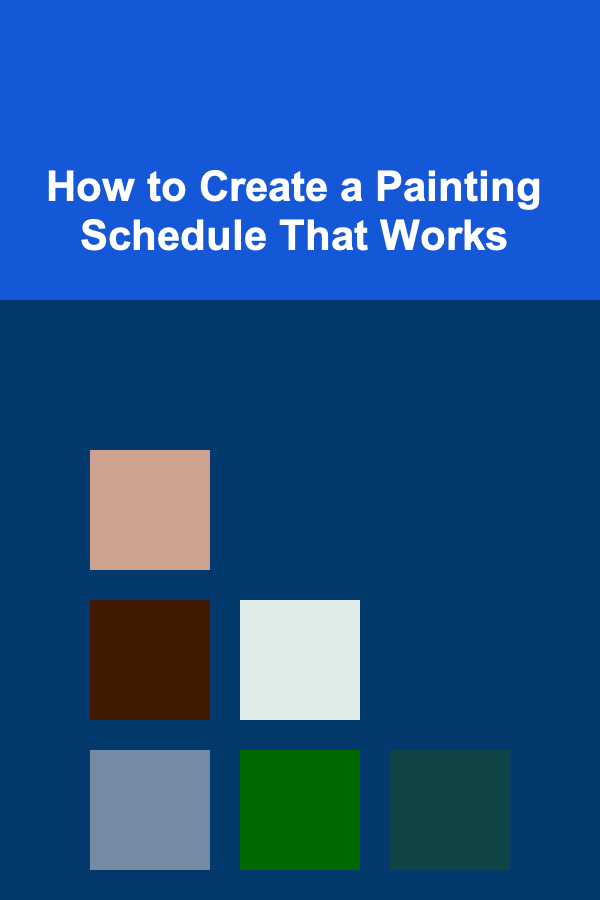
How to Create a Painting Schedule That Works
ebook include PDF & Audio bundle (Micro Guide)
$12.99$8.99
Limited Time Offer! Order within the next:

Painting is not only a creative endeavor, but for many artists, it's also a professional pursuit that requires planning and dedication. Whether you're a hobbyist looking to improve your skills or a professional artist aiming to complete a series of works, having a painting schedule can help you stay productive, motivated, and focused. In this article, we will delve into the essential steps for creating a painting schedule that works---one that fits your lifestyle, boosts your creativity, and ultimately helps you achieve your artistic goals.
Understanding the Importance of a Painting Schedule
A painting schedule is a tool to help you allocate time for your artistic process, organize your workload, and ensure steady progress. Just like in any profession, having a structured approach to your work can bring a sense of purpose and clarity, which can be crucial when the process of creating art feels daunting or chaotic.
Here are a few reasons why a painting schedule is important:
- Consistency Leads to Improvement: Painting regularly helps you improve your technique and develop your artistic voice. A schedule helps you make time for practice.
- Helps Meet Deadlines: Whether you're working on commissions, preparing for exhibitions, or trying to complete a project, having a schedule helps you stay on track to meet deadlines.
- Increases Productivity: When you have specific blocks of time dedicated to painting, you're more likely to start and finish projects without feeling overwhelmed.
- Fosters Creativity: Sometimes, creativity needs space and time to develop. By creating a routine, you allow yourself the mental space to explore ideas without the pressure of constantly trying to "fit in" creative time.
Understanding these benefits helps you approach your painting schedule with the right mindset.
Identify Your Goals and Priorities
Before you set up a schedule, it's crucial to understand your goals as an artist. These goals will shape how you approach your painting routine and will influence how much time you dedicate to painting each week.
Determine Your Artistic Goals:
- Improving Technique: If your goal is to master a specific technique, such as oil painting or watercolor, your schedule should include time for focused practice.
- Creating a Body of Work: If you're preparing for an exhibition or completing a series of paintings, you'll need a schedule that allows for both creating new works and reviewing your progress.
- Working on Commissions: If you take commissions, you may need to prioritize client work over personal projects. Your schedule should account for deadlines and client expectations.
- Exploring New Styles or Media: If you're trying to experiment with different styles or media (e.g., digital painting, sculpture), your schedule should balance time for exploration with your ongoing projects.
Once you have your goals defined, it will be easier to prioritize what needs attention and adjust your time commitments accordingly. A clear understanding of your artistic objectives will also help you stay motivated.
Assess Your Available Time
After defining your artistic goals, the next step is to assess your available time. How much time can you realistically devote to painting each week? Whether you're balancing painting with a job, school, family commitments, or other hobbies, knowing your time constraints is essential in designing a practical painting schedule.
Factors to Consider:
- Daily Routine: Consider your daily schedule, including work, meals, chores, and personal time. Identify pockets of time when you could realistically sit down and paint.
- Energy Levels: Painting requires not only time but mental energy. Are you most creative in the morning, afternoon, or evening? Knowing when you're at your peak energy levels will help you schedule your painting time for maximum focus.
- External Obligations: If you have other responsibilities, such as a job or family commitments, make sure you account for them. Your painting schedule should work in harmony with your overall lifestyle.
- Personal Time and Breaks: Don't forget to schedule breaks to avoid burnout. Artistic work can be mentally taxing, so it's important to allow yourself time to rest and recharge.
Once you know your available time, you can better allocate your painting hours without overwhelming yourself.
Breaking Your Schedule Into Manageable Blocks
Instead of setting a rigid, all-day painting schedule, break it down into manageable blocks. These blocks should be tailored to fit your working style, energy levels, and goals. For some artists, long, uninterrupted sessions are ideal, while others thrive in shorter, more frequent bursts.
Time Blocks for Different Needs:
- Daily Sessions: If you're able to paint every day, schedule small sessions of 1-2 hours. These shorter blocks prevent exhaustion and help maintain consistent progress.
- Longer Sessions for Detailed Work: If you're working on intricate details or need larger chunks of time to immerse yourself in a project, aim for longer sessions (3-5 hours). Just make sure you're not overloading yourself.
- Weekly Goals: If daily painting isn't feasible, consider creating a schedule based on the week. Allocate 2-3 painting sessions per week, and set specific targets for each session (e.g., sketching, underpainting, final details).
- Theme Days: If you like to work on multiple projects or mediums, consider assigning specific days for different tasks. For instance, you might set Mondays for sketching, Wednesdays for painting, and Fridays for experimenting with new materials.
Make sure that your blocks are realistic and flexible, allowing you to adjust when necessary.
Incorporate Preparation and Reflection Time
Creating art is not just about the actual painting process; preparation and reflection are equally important. To make the most of your painting schedule, dedicate time for the following:
- Preparation Time: Preparing your workspace, setting up materials, and organizing your reference materials are crucial to a smooth painting process. Even a 15-minute setup before each session can help you get into the right mindset and reduce distractions during your painting time.
- Reflection Time: After each session, take a few moments to reflect on your progress. This could be in the form of journaling, noting down your thoughts, or simply evaluating what worked and what didn't. Reflection allows you to track your growth, make improvements, and identify what you need to focus on next.
- Artistic Breaks: Allowing yourself space to step away from your artwork is essential for creative replenishment. A break doesn't necessarily mean doing nothing---taking a walk, sketching, or engaging with other forms of art can also serve as valuable downtime.
By scheduling preparation and reflection time, you ensure that each painting session is productive and that you continue to grow as an artist.
Stay Flexible and Adjust as Needed
While it's important to stick to your painting schedule as much as possible, life has a tendency to throw unexpected challenges your way. Work commitments, personal obligations, and moments of creative burnout are all part of the process. It's essential to remain flexible and make adjustments when necessary.
Here are some tips for maintaining flexibility:
- Shift Sessions: If you can't paint at your usual time, move your painting session to a different time of day or a different day entirely.
- Reevaluate Priorities: If you find that your schedule isn't working for you, reassess your goals and available time. Don't be afraid to adjust your plan to better suit your life circumstances.
- Practice Self-Compassion: Not every painting session will go according to plan. Don't be too hard on yourself if you miss a session or if a painting doesn't turn out as expected. Artistic growth involves both success and setbacks.
Allow yourself room to adjust, and remember that the goal is consistent progress, not perfection.
Track Your Progress
Tracking your progress is a vital part of maintaining motivation and ensuring that your painting schedule is working effectively. Consider keeping a painting journal or digital log where you can note your progress, achievements, challenges, and future goals.
Here's what to track:
- Completed Works: Keep a list of the paintings you've completed during each week or month. This helps you see your growth and stay motivated.
- Techniques and Styles: Track the new techniques you've tried or the different styles you've experimented with. This can help you stay intentional with your artistic development.
- Time Spent: Keep an eye on how much time you're actually spending painting. If you find yourself consistently falling short, it might be worth reexamining your schedule or adjusting your expectations.
Tracking helps you stay on course, gives you a sense of accomplishment, and ensures that you're meeting your artistic goals.
Consider External Deadlines
If you're working on commissioned pieces or preparing for an exhibition, external deadlines will play a significant role in your painting schedule. Make sure to incorporate these deadlines into your planning and allow plenty of time for revisions, critiques, and final touches.
How to Manage Deadlines:
- Plan Backwards: For external deadlines, start by noting the final deadline and work backwards to establish smaller milestones.
- Allow Extra Time for Revisions: Factor in extra time for changes or revisions. Creative work often needs tweaking, so always build in some flexibility.
- Prioritize: If you're juggling multiple projects with different deadlines, prioritize those that are most time-sensitive. This ensures you're staying on top of your responsibilities.
Managing external deadlines effectively ensures you meet your obligations without compromising the quality of your work.
Creating a Sustainable Routine
While your painting schedule should be structured, it's important to remember that your routine must be sustainable. Creative work requires mental clarity and energy, so be mindful of burnout. Here's how to create a balanced and sustainable routine:
- Avoid Overloading: Don't schedule more time than you can realistically handle. Painting is a demanding task, and overcommitting will lead to burnout.
- Celebrate Small Wins: Acknowledge your progress, no matter how small. Whether it's finishing a painting or mastering a new technique, celebrating small victories helps you stay motivated.
- Practice Patience: Artistic work takes time. It's important to be patient with yourself and the process, and to trust that consistency will lead to improvement.
Conclusion
Creating a painting schedule that works is about finding a balance between your personal goals, available time, and creative process. By setting clear goals, understanding your time constraints, and allowing for flexibility, you can develop a routine that fosters creativity and ensures steady progress. Remember, the most important thing is to stay consistent, track your progress, and adapt as necessary to keep your creative journey both productive and enjoyable.
With the right mindset and a thoughtful approach, your painting schedule will become a powerful tool for both artistic growth and personal fulfillment.
Reading More From Our Other Websites
- [Sewing Tip 101] From Fabric Scraps to Chic Curtains: A Step-by-Step Sewing Guide
- [Personal Care Tips 101] How to Choose the Right Makeup Remover for Your Skin's Needs
- [Polymer Clay Modeling Tip 101] From Beads to Miniatures: Exploring the Versatile World of Polymer Clay Hobbies
- [Home Holiday Decoration 101] How to Create a Holiday-Themed Gallery Wall
- [Personal Care Tips 101] How to Use Shaving Cream to Prevent Shaving Rash
- [Scrapbooking Tip 101] Budget‑Friendly Scrapbooking: Affordable Supplies and Hacks for Beautiful Pages
- [Biking 101] Top 5 Bike Brakes for Maximum Stopping Power and Control
- [Home Party Planning 101] How to Choose the Right Music Playlist for Your Party
- [Organization Tip 101] How to Share Your Seasonal Organization Tips Online
- [Home Staging 101] Best Home Staging Tips for First‑Time Homebuyers

How to Improve Website Navigation for Better User Experience
Read More
How to Prevent Echoes in Your Home with Soundproofing Tips
Read More
How to Choose Healthy Protein Powders
Read More
How to Design a To-Do List Planner for Minimalists
Read More
10 Tips for Managing Errands with a Busy Schedule
Read More
How to Build a Multimedia Artist Portfolio That Gets You Hired
Read MoreOther Products

How to Improve Website Navigation for Better User Experience
Read More
How to Prevent Echoes in Your Home with Soundproofing Tips
Read More
How to Choose Healthy Protein Powders
Read More
How to Design a To-Do List Planner for Minimalists
Read More
10 Tips for Managing Errands with a Busy Schedule
Read More